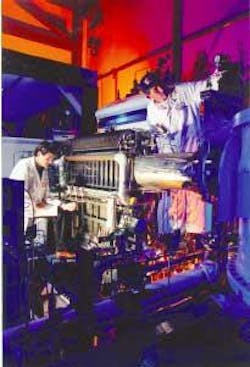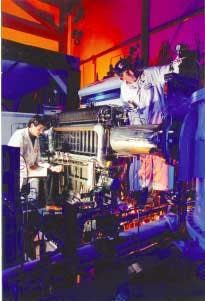Airborne Laser achieves 'first light' milestone
The Airborne Laser met its objectives when it achieved “first light” of six laser modules firing simultaneously on Nov. 10, 2004, program manager Col. Ellen Pawlikowski told a post-test briefing held in Washington, D.C. But while she was happy to report the successful test, she made it clear the program has a long road ahead before its final milestone: shooting down a test missile in the air. The Missile Defense Agency (MDA) estimates that meeting that milestone will cost about $1.39 billion.
The first-light demonstration of the chemical oxygen-iodine laser required integrating six laser modules in a mockup of a Boeing 747 in a hanger at Edwards Air Force Base in California. The MDA had earlier fired a single module (see figure). In February 2004, MDA restructured the program, setting first light for the laser and the first flight of the beam-control system as the key milestones for 2004.
Firing the laser was a welcome success, although it came 20 months behind the original schedule. In fact, achieving “first light” is critical to continuation of the project, negotiators from the House of Representatives and Senate armed services committees said in a report accompanying the 2005 Defense Authorization Act. Congress authorized President George Bush’s request for $474.3 million for the program in fiscal 2005 as part of the $10 billion budgeted for missile-defense development and deployment.
Verifying the physics
"This was our verification that in the design of the six modules together we had the right physics in order to produce the medium required to actually -create and sustain a megawatt-class laser beam," Col. Pawlikowski told reporters. It also verified that subsystems performed as designed when integrated, including optical diagnostics, thermal management, pressure recovery, and fluid management.
Missile Defense Agency engineers spent eight days bringing all the subsystems up and verifying that they were stable and could be started and restarted. Temperatures of the basic hydrogen peroxide fuel circulated within the laser remained within one degree of the set point for all eight days. Resonator alignment was maintained within one millimeter. To prevent potential pressure spikes from causing any problems, chlorine flow was limited to about 80% of the full-power goal, and a timer was set to shut down the laser as soon as the beam was detected.
It worked on the first try. The power wasn't measured, but it was respectable. A calorimeter measured a clear temperature rise of several degrees, and MDA engineers saw "fireflies"—residual dust ignited by the laser beam—before the control system shut down the laser.
Pawlikowski expected further tests to begin early in December after several system modifications. The first test was aborted prematurely, so engineers will adjust the sensors and control system. They will also upgrade the chlorine system to operate at full capacity, and adjust other systems. Then they will begin a series of ground tests that will gradually crank up the output power until the laser can sustain full power for the time that will be needed to destroy a target missile. That is expected to take the rest of this fiscal year.
Meanwhile, MDA hopes to get the modified 747 off the ground in December to begin a series of tests on the fire-control and beam-control systems that have already been installed. The first few flights will verify aeronautical performance. The next set of flights will test how the optics perform when subjected to flight vibrations. Then engineers will install a 10-W solid-state laser as a surrogate for the high-power laser to assess how well a low-power beam can track targets.
Early in 2005, MDA officials will set goals for the next year. Trials of the -laser on the ground are likely to continue until the end of the fiscal year (September 30). In addition to verifying that the laser can reach full power, they will test its performance at various pressures. Then the laser will be disassembled and rebuilt inside the 747 so it can be flown and tested in the air. The ultimate goal is to shoot down a target missile, but MDA has decided to work step by step through a series of intermediate milestones to assess its knowledge before scheduling the crucial shot. Judging from MDA's estimate of $1.39 billion to finish the job, that's likely to be two or three years away.

